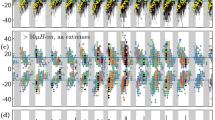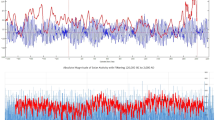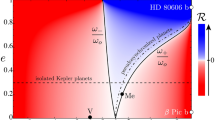Abstract
ON May 8 there appeared on the sun's eastern limb an equatorial sun-spot in a region which has been without disturbance for some considerable time. It was an active spot which had separated by May 12 into two large spots. The maximum area of the group was 16.5, in units 1/5000 of the sun's visible disc, and this was attained on May 14. The leader spot of the group was a composite spot containing two umbræ. Its mean heliographic co-ordinates on that date were latitude +1.4°, longitude 6.4°. The following spot was a large single spot, and its co-ordinates were latitude 0.2°, longitude 358.8°. The whole group extended over 12° in longitude and about 6° in latitude, so that a considerable area of the sun's surface was disturbed.
This is a preview of subscription content, access via your institution
Access options
Subscribe to this journal
Receive 51 print issues and online access
$199.00 per year
only $3.90 per issue
Buy this article
- Purchase on Springer Link
- Instant access to full article PDF
Prices may be subject to local taxes which are calculated during checkout
Similar content being viewed by others
Author information
Authors and Affiliations
Rights and permissions
About this article
Cite this article
CORTIE, A. The Great Sun-spot Group and Magnetic Disturbances, May 8–21. Nature 107, 426–427 (1921). https://doi.org/10.1038/107426a0
Issue Date:
DOI: https://doi.org/10.1038/107426a0
Comments
By submitting a comment you agree to abide by our Terms and Community Guidelines. If you find something abusive or that does not comply with our terms or guidelines please flag it as inappropriate.



